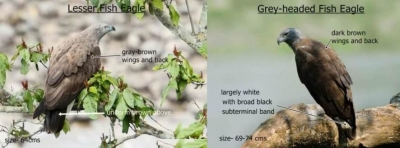
The gray-headed fish eagle or Haliaeetus ichthyaetus, is a smallish to medium-sized, bulky fish eagle found in South East Asia. Adults have a dark-brown or gray upper body, gray head and white underbelly and legs. These birds are sometimes mistaken for the lesser fish eagle which is similar in plumage. However the gray-headed fish eagle is larger in size to the lesser fish eagle. It is 61-75 cm long with a wingspan of 155-170 cm. Females are larger and heavier at 2.3 to 2.7 kg, compared to males at 1.6 kg.
As its name suggests, this eagle primarily consumes fish and occasionally eats reptiles, small mammals and other birds. It spends much time perched upon trees near water bodies, scanning the surface for fish. When it spots a suitable prey, it swoops down and scoops it up in strongly recurved talons specialized to catch fish. It is known to be a dynamic hunter and can even catch fish in rough water, such as rapids.
This eagle is found in India, Sri Lanka, Malaysia, Indonesia and the Philippines. In India it is found in Rajasthan, Uttar Pradesh, Bihar and Assam. It is called ‘tank eagle’ in Sri Lanka due to the fact that it is generally found in the vicinity of irrigation tanks. It lives in lowland forests up to 1,500 m above sea-level. It makes its nests close to water bodies like rivers, streams, lakes, lagoons, reservoirs, marshes, swamps and estuaries.
It has a variety of calls including a gurgling ‘awh-awhr’ and a honking ‘uh-wuk’ and a loud, high pitched scream. It becomes quite vocal during the breeding season with calls and vocalizing continuing into the night.
It builds a stick and leaf nest which is 1.5 m across and around 2 m deep on a tall tree near a water source. The female lays 2 to 4 unmarked, white eggs. Incubation and foraging duties are shared by males and females and incubation lasts between 45 and 50 days.
Although the gray-headed fish eagle is not threatened with extinction, its population is declining. This is a result of loss of wetland habitat, deforestation, persecution and human pollution which affects its food supply and nesting sites.
Picture Credit : Google




